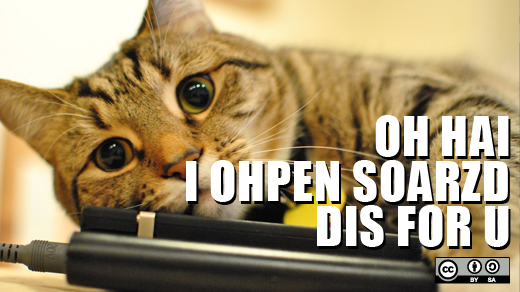At OSCON this year, Regina ten Bruggencate and Kim Spiritus gave a talk called How To Get More Kids To Code. I got in late (I was waiting in line to get a free signed copy of The Art of Community by Jono Bacon) so I missed the beginning of this session, but came in as they were demoing Scratch. This is a website where kids can play little games (available in 40 languages) and then click the 'See inside' button to see the code behind the game in a kid friendly way. It’s a great way to get kids to see code and learn not just programming, but the concepts of open source.
Next up was Alice meant for kids ages 8 and up. This site uses a story telling type of learning to program. For some reason boys don’t seem to like Alice very much (they’re not really sure why since the kids can use aliens and spaceships in their stories). Using Alice you can drag and drop objects in to your scene/story and when you do it pops up windows where you enter properties for the items. Once you have your scene set up you can edit the code by clicking on the object (your alien for example), but the edit screen is not your standard 'code' view, instead it’s friendly to kids by giving them pull down menus of actions.
Greenfoot is meant for slightly older kids (12+), but works similarly to Alice. The code editor in this shows you the Java with a bit of color coding (unlike the other tools that showed code in easy to use bubbles). Greenfoot is actually just a visual interface on top of BlueJ.
Another option is to use Mindstorms, which walks kids through creating a robot and programming the "brain." Mindstorms is great for kids age 8 and up.
Sagan is an open source project where you can simulate the Mars rover. It comes with three Mars landscapes and you program your rover to move around. It even has conversion tools so you can load it in to a Mindstorms robot (and others).
Arduino is a great way to teach kids about programming and electronics (and it’s not only for kids!).
Raspberry Pi is a computer with a flash hard drive that will take any Linux distribution. I has two USB ports (keyboard and mouse), an ethernet port, and a port to connect to your TV. This is a great way to let the kids see the inside of the computer and work with it and programming on it. Quite a few people actually use this as a media center.
In addition to tools, there are events out there for kids. Devoxx 4 Kids is a one day convention with a keynote in the morning and parallel tracks during the day. In the sessions they learn about all of the tools listed above. The speakers are all computer professionals like us who want to get the kids involved. The first one in the Netherlands was sold out in two hours!!
Another initiative is the First Lego League which is a robotics project for kids. The kids have to create a Lego Mindstorms robot from scratch and then they have to share their solutions with the other teams (so a very open environment). There are competitions as well, but teams are not required to compete.
Maker Faire happens all around the world where kids can share what they have created—a place to share your love of science and building things.
VHTO is a program for girls in the Netherlands where kids can participate in different types of programs like Talent Watcher where they get to find where their talents lie. They also have a program called Mirror Image which shows them women in technical fields that they could participate in. Another program they offer is Speeddating where they get to decide if they want to go in to a more technical field than most girls might choose. They also have Girlsday where girls can visit the company to see what it’s like to be in that field.
Originally posted on What I Learned Today. Reposted using Creative Commons.







11 Comments